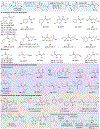Visible-light-induced coupling of carboxylic acids with alcohols/amines via a phosphorous linchpin strategy
- PMID: 37547627
- PMCID: PMC10399973
- DOI: 10.1016/j.chempr.2023.04.011
Visible-light-induced coupling of carboxylic acids with alcohols/amines via a phosphorous linchpin strategy
Abstract
The combination of activated carboxylic acids and alcohols/amines to access esters and amides, respectively, is a cornerstone of organic chemistry and has been well developed over the past century. These dehydrations are extensively used in medicinal chemistry and natural product synthesis due to the prevalence of these functional groups in bioactive molecules. Here, we report a divergent process from the expected ester/amide outcomes through a light-induced coupling of activated carboxylic acids and alcohols/amines to efficiently prepare α-hydroxy/amino ketones or β-ketophosphonates via single-electron chemistry. A phosphorus linchpin strategy allows for the combination of these simple reagents through an intramolecular triplet state radical process, thereby enabling new carbon-carbon bond formation.
Keywords: alcohols/amines; carboxylic acids; posphorous linchpin; α-functionalized carbonyl compounds.
Conflict of interest statement
DECLARATION OF INTERESTS The authors declare no competing interests
Figures





References
-
- Davis FA, and Chen BC (1992). Asymmetric hydroxylation of enolates with N-sulfonyloxaziridines. Chem. Rev 92, 919–934. 10.1021/cr00013a008 - DOI
Grants and funding
LinkOut - more resources
Full Text Sources
Miscellaneous
